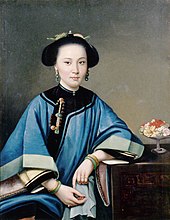This article includes a list of general references, but it lacks sufficient corresponding inline citations. (September 2020) |


Concubinage in China traditionally resembled marriage in that concubines were recognized sexual partners of a man and were expected to bear children for him. Unofficial concubines (Chinese: 婢妾; pinyin: bì qiè) were of lower status, and their children were considered illegitimate. The English term concubine is also used for what the Chinese refer to as pínfēi (Chinese: 嬪妃), or "consorts of emperors", an official position often carrying a very high rank. The practice of concubinage in China was outlawed when the Chinese Communist Party came to power in 1949.[1]
- ^ Patricia Buckley Ebrey (2002): Women and the Family in Chinese History. Oxford: Routledge, p. 39.
